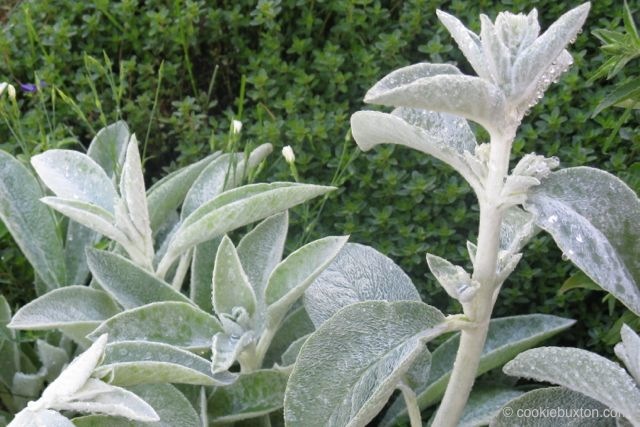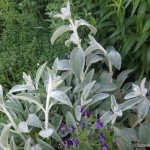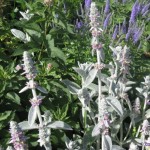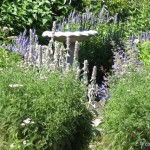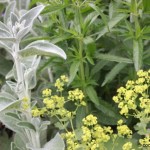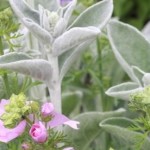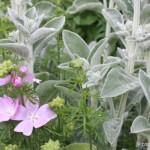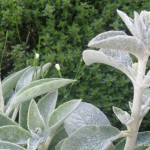Woolly Lamb’s Ears
Silver-grey Woolly Lamb’s Ears is one of the most delightfully named plants in the lexicons, and certainly among the nicest to touch. When it comes to colour palettes, if you are seeking silver-grey plant selections for your home garden, Woolly Lamb’s Ears – Stachys byzantina – is a wonderful choice.
This soft, fuzzy-leaved plant does well in Zone 3 gardens and above. It takes no extra care to sustain Woolly Lamb’s Ears in our northern climate. The only plants still looking even half-alive in my garden on this sunny November day are the base leaves of Lamb’s Ears, the flowering maroon and rust-orange tops of snap dragons, and some very late blooming pink mallow survivors. We’ve had several nights of frost that ended the growing season, but cheerful Lamb’s Ears still sits tucked in with the snap dragons along a south-facing white stucco wall.
In spring, Lamb’s Ears are a little slow to get going in Manitoba. I’ve usually cut down the flowering stems after they flower, and again for winter, or they have withered on their own accord. The base leaves in the spring are mushy brown clumps, but then one little, soft, fuzzy spring-green leaf will push through. I don’t touch the plants in spring, and let them take their sweet time to grow before cleaning up the dead lower leaves. This helps keep the plant warm and protects the new growth, since in northern climates it is a common lament that many evenings well into late spring can still end with frost or dustings of snow.
From early June onward, Woolly Lamb’s Ears will begin to develop and spread. It is a wanderer, showing up fairly reliably in its last year’s locations, and cropping up nearby in new choice spots where the soil is dry and the sun shines for good parts of the day.
The most distinctive feature of Lamb’s Ears, and hence the name, is its soft, fuzzy silver-grey-green leaves. The leaf surface is delightful to touch, very nice to look at, and makes soft Woolly Lamb’s Ears popular with children.
Its lavender-pink flowers, though they are little, encircle the flowering stem in a pretty fashion, looking a bit like very tiny, old-fashioned skirt crinolines. When massed together, the plants create a wave of the softer colours in the summer garden palette. Some years back, I visited a property where a long, pie-piece stretch of urban front yard was covered in Lamb’s Ears plantings. The plants encircled a small oasis of shade created by a few flowering trees. The effect was stunning,
Woolly Lamb’s Ears are highly attractive to bees and other nectar-lovers. Keep this in mind when moving them around your yard. When they are too close to the walkways, I know that guests to my garden will be brushing their legs close to the plants. I like to keep Lamb’s Ears set a little bit back. However, I have broken this general rule in a couple of places, and did so for the location near the snap dragons, simply because Lamb’s Ears like the dry soil and amount of direct sun there, under the eaves, whereas other plants die regularly because I forget to water them. Lamb’s Ears are perfectly suited to my carefree habits.
Some garden books describe Lamb’s Ears as an invasive-slash-aggressive weed. Certainly it does travel, both by root spread and self-seeding distribution, and in the Mediterranean regions and hot, sunny counterparts in North America and elsewhere, that can cause problems and push the plant into “weed” status. In the short-season northern garden, that problem becomes an asset. This attractive, spreading, fairly tall, Zone-3 worthy, interesting-looking, and durable plant that wanders about and prefers poor soil and dry, sunny locations, is the perfect option for some garden settings. Have you had some winter-kill? Do you need a filler where not much else will grow? Do you need a plant that will establish itself and bloom this season? Do you like pretty little flowers? Think through where you will situate the plant, and consider that it will fill out and move around. If this plant’s “nature” suits you, welcome to the Lamb’s Ears fan club.
Woolly Lamb’s Ears, also called Woundwort, Woolly Woundwort, Betony, and Hedge Nettle, is a perennial plant. Lamb’s Ear is a member of the mint family and is reputed to have medical properties. Good keywords for online searches for herbal and medical information include Woolly Woundwort, Woolly Lamb’s Ears, S. lanata, S. byzantina, S. olympica, and the Stachys genus, which boasts over 300 species of annuals, perennials, and evergreen shrubs.
Photos & Text: NK
Copyright: NK/cookiebuxton.com
Photograph location: NK home garden
Photo Gallery
Click on any photograph to enlarge the image. Click on the enlarged photograph to advance through the series.
